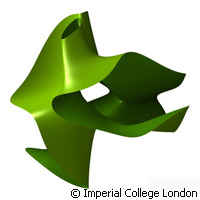Name that shape! Building blocks for 5D universe
An EU-funded team of researchers has set out to provide mathematicians with their very own periodic table ... of shapes. Researchers at Imperial College London in the UK are collaborating with colleagues in Australia, Japan and the Russian Federation to identify the basic building blocks of all possible shapes in the universe across three, four and five dimensions, and analyse how these components relate to each other. The three-year project is funded in part by the European Research Council (ERC), whose grants are channelled through the Ideas Programme of the EU's Seventh Framework Programme (FP7). Project leader Alessio Corti from Imperial College London's Department of Mathematics, explains the objectives: 'The periodic table is one of the most important tools in chemistry. It lists the atoms from which everything else is made, and explains their chemical properties. Our work aims to do the same thing for three-, four- and five-dimensional shapes - to create a directory that lists all the geometric building blocks and breaks down each one's properties using relatively simple equations.' The team believes some 500 million shapes can be defined algebraically in 4 dimensions. Among these shapes, they are expecting to identify several thousand which cannot be divided further: the basic building blocks from which all other shapes are made. Team member Tom Coates, a colleague of Professor Corti's at the Department of Mathematics, has developed a computer modelling programme that will assist the researchers with this gigantic task. Ambitious as it may be, identifying these shapes and working out the equations that describe them is, however, just one of the team's objectives. The scientists are also planning to analyse how these components will affect the shapes into which they combine. 'You can think of these basic building blocks as "atoms", and think of larger shapes as "molecules". The next challenge is to understand how properties of the larger shapes depend on the "atoms" that they are made from. In other words, we want to build a theory of chemistry for shapes,' says Dr Coates. One of the most intriguing aspects of this research lies in the fact that many of these shapes are not actually visible in their full, multidimensional complexity. In addition to the three spatial dimensions which shape our daily lives, even factoring in the concept of time as a fourth dimension can be tricky. The project will be considering up to five dimensions, and indeed string theory assumes that there may be many more. 'Most people are familiar with the idea of three-dimensional shapes,' says Dr Coates, 'but for those who don't work in our field, it might be hard to get your head around the idea of shapes in four and five dimensions. However, understanding these kinds of shapes is really important for lots of aspects of science.' Such, for example, as number theory, theoretical physics and computer vision. 'If you are working in robotics, you might need to work out the equation for a five-dimensional shape in order to figure out how to instruct a robot to look at an object and then move its arm to pick that object up', says Dr Coates. 'If you are a physicist, you might need to analyse the shapes of hidden dimensions in the universe in order to understand how sub-atomic particles work.' So the team's efforts may well deliver a key reference for research in many disciplines - although the table is unlikely to be adorning the classrooms of future generations. 'We think we may find vast numbers of these shapes,' says Professor Corti, 'so you probably won't be able to stick our table on your wall, but we expect it to be a very useful tool.' Support for the project also comes from the UK's Engineering and Physical Sciences Research Council, Leverhulme Trust and Royal Society.For more information, please visit: Imperial College London: http://www3.imperial.ac.uk European Research Council (ERC): http://erc.europa.eu/ Ideas Programme: http://ec.europa.eu/research/fp7/index_en.cfm?pg=ideas
Countries
Australia, Japan, Russia, United Kingdom

